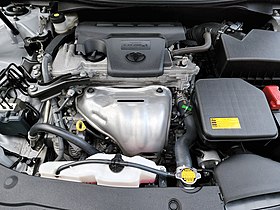|
Toyota AR engine
The AR engine family is an Inline-4 piston engine series by Toyota, first introduced in 2008 for the RAV4, and subsequently for the Highlander, Venza, Camry and Scion tC. The AR series uses a die-cast aluminium engine block and aluminium DOHC cylinder head. The engine series shares many of the technologies in the AZ engine, while incorporating features such as variable valve timing on both intake and exhaust camshafts or dual VVT-i, low friction technologies including an offset crankshaft, roller rockers for the valvetrain, a three-stage variable oil pump, reduced-tension piston rings and auxiliary belt drive. An Acoustic Control Induction System switches the length of the intake tract in two stages, based on rpm and throttle angle, thereby ensuring strong torque across a broad engine speed range. New tumble control valves enhances combustion while the engine is cold, and helps to bring the catalytic converters up to working temperature quickly. The Tumble control valves, along with new 12-hole high atomizing long-nozzle fuel injectors, reduce the amount of fuel adhering to the intake ports and therefore maximize fuel economy and reduce harmful emissions. The cylinder block is an open-deck, midi-skirt type with cast-in iron liners and a die-cast aluminium lower crankcase and a stamped oil pan. The forged steel crankshaft is fully balanced with eight counterweights and supported by five main bearings. A helical gear pressed in No. 3 counterweight drives twin contra-rotating balance shafts in the shaft housing within the lower crankcase. The AR engine replaces the AZ engine. 1AR-FE
A 2.7 L version of the AR family, first released in the Venza[1] and Highlander in late 2008.[2] The 1AR-FE most likely ended production in 2020. No official statements were made by Toyota about the engine's status, however, no new cars used this engine after 2020. It was replaced by the A25A-FKS engine. Applications:
2AR-FE
A 2.5 L version of the AR family, first released in the RAV4 in the U.S. and Canada in 2008.[3] This engine also replaced the 2AZ-FE in the U.S. and Canada Camry in early 2009, giving 11% better fuel economy.[4] The engine service mass is 324 lb (147 kg) that includes the oil and coolant fully filled. The engine is used in vehicles sold in Japan, U.S., Australia,[5] New Zealand,[6] China, Taiwan, Korea, Malaysia, Philippines, Thailand[7] Indonesia, and Middle East. Applications:
2AR-FXE
The 2AR-FXE[8] is an Atkinson cycle variant of the 2AR-FE. It has the same bore and stroke, but the cams and pistons are unique. Only the intake valves are variable with VVT-i.[9] Geometrical compression ratio is 12.5:1 The large valve overlap leads to a reduction in cylinder charge and reduced torque and power output, but efficiency is increased. This combination makes the 2AR-FXE suitable for use in hybrid vehicles, where peak torque and power demands can be met by the electric motor and battery. Maximum output of the engine when used in the Camry hybrid is 154 hp with 153 lb·ft of torque. Applications:
2AR-FSEThe 2AR-FSE [10] is a variant of the 2AR-FE equipped with D4-S direct-injection and port injection. It has the same bore and stroke as other 2AR engines but the cylinder head, cams, pistons and fuel management system are unique. Maximum thermal efficiency is about 38.5%.[11] The expansion ratio is 13.0 to 1. Output in the Toyota Crown hybrid combined is 164 kW (220 hp) at 6000 rpm and 221 N⋅m (163 lbf⋅ft) at 4200–5400 rpm. Applications: 5AR-FE
A 2.5 L version of the AR family, first released in the RAV4 in China in 2013.[13] Applications: 6AR-FSEThe 6AR-FSE is a 4-cylinder, 1998 cc, twincam, petrol engine equipped with D4-S direct fuel injection and VVT-iW. It can work in the Otto cycle and a modified-Atkinson cycle depending on output power. It was first introduced in the Camry in December 2014 for the Chinese market and March 2015 for the Thai market. The output of 6AR-FSE is 123 kW (165 bhp) at 6500 RPM and 199 N⋅m (147 lbf⋅ft) at 4600 RPM.[14] The stroke and bore are 86 mm × 86 mm (3.4 in × 3.4 in). Applications:
6AR-FBSThe 6AR-FBS is a 4-cylinder, 1998 cc, twincam, petrol engine equipped with D4-S direct fuel injection and VVT-iW. It can work in the Otto cycle and a modified-Atkinson cycle depending on output power. It was first introduced in the Camry in October 2018 for the Thai market. The output is 167 PS (123 kW; 165 bhp) at 6500 RPM and 199 N⋅m (147 lbf⋅ft) at 4600 RPM.[16] Applications:
8AR-FTS A 2.0 L turbocharged direct-injected member of the AR family, fitted with VVT-iW it is able to operate in both the Otto and a modified-Atkinson cycle. Debuted in the Lexus NX200t.[17] Power output in the 2015 NX200t is 175 kW (235 hp) at 4,800 - 5,600 rpm and 350 N⋅m (258 lb⋅ft) at 1,650 - 4000 rpm. The 8AR-FTS engine has Lexus’ ESTEC D-4ST (Economy with Superior Thermal Efficient Combustion Direct injection 4-stroke with Turbo) fuel injection. With separate twin injectors for both direct and port injection, ESTEC D-4ST could perform high-pressure direct injection into the cylinder and conventional intake port injection, or direct cylinder injection only, according to engine speed.[18] Power output in some applications, e.g. Lexus IS 200t XE30, Lexus GS 200t and Lexus RC 200t is bumped up by 5 kW (6.7 hp) up to 180 kW (242 hp) in the same rev range but torque remains the same.[18] Applications:
ProductionIn Japan built by Toyota Motor Corporation in Kamigo Plant and by Toyota Industries Corporation.[24][25] Toyota Motor Manufacturing Alabama, Inc. (TMMAL) started building the AR 2.5L and 2.7L engines beginning in mid-2011.[26] GAC Toyota Engine Co., Ltd Guangqi, China, announced start of AR 2.5L and 2.7L engine production November 2011[27] Toyota Australia officially opened its new engine plant producing both petrol and hybrid engine variants in Melbourne.[28] See alsoReferences
|
||||||||||||||||||||||||||||||||||||||||||||||||||||||||||||||||||||||||||||||||||||||||||||||||||||||||||||||||||||||||||||||||||||||

